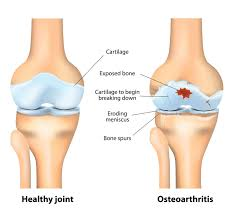A nurse is assessing a client newly diagnosed with early-onset osteoarthritis. Which manifestation should the nurse expect?
Ulnar deviation.
Symmetric joints are affected.
Weight loss.
Joint stiffness and limited range of motion.
The Correct Answer is D
Choice A reason:
Ulnar deviation, which is the angling of the fingers towards the little finger side of the hand, is more commonly associated with rheumatoid arthritis, not osteoarthritis. Osteoarthritis typically affects the joint's cartilage, leading to pain and stiffness, rather than causing the fingers to deviate.
Choice B reason:
Symmetric joint involvement is also more characteristic of rheumatoid arthritis. Osteoarthritis usually affects joints asymmetrically, meaning it's more likely to affect one side of the body or one particular joint at a time.
Choice C reason:
Weight loss is not a direct manifestation of osteoarthritis. In fact, being overweight is a risk factor for developing osteoarthritis due to the increased stress on weight-bearing joints. However, weight management through diet and exercise can be part of the treatment plan for osteoarthritis to alleviate symptoms and improve joint function.
Choice D reason:
Joint stiffness and limited range of motion are hallmark manifestations of osteoarthritis. These symptoms result from the breakdown of cartilage within the joints, which leads to pain and difficulty moving the affected joint. Stiffness is often most noticeable upon waking or after periods of inactivity, and the range of motion may decrease as the condition progresses.

Nursing Test Bank
Naxlex Comprehensive Predictor Exams
Related Questions
Correct Answer is A
Explanation
Choice A Reason:
Dantrolene is used in the management of malignant hyperthermia, a life-threatening complication characterized by muscle rigidity and elevated temperature, often triggered by certain anesthetics. The patient's symptoms of muscle rigidity and brown urine, which may indicate myoglobinuria, along with elevated temperature and heart rate, are suggestive of this condition. Dantrolene acts by reducing calcium release from the sarcoplasmic reticulum of skeletal muscle, thereby reducing muscle contraction and metabolic demand.
Choice B Reason:
Metoprolol, a beta-blocker, is not the first-line treatment for symptoms suggestive of malignant hyperthermia. While it can reduce heart rate and blood pressure, it does not address the underlying pathophysiology of malignant hyperthermia and is not indicated in this scenario.
Choice C Reason:
Increasing the rate of lactated Ringer's solution is not the primary intervention for malignant hyperthermia. While maintaining hydration is important, it does not directly counteract the pathophysiological processes at play in malignant hyperthermia.
Choice D Reason:
While liver function tests can be important in assessing overall organ function post-operatively, they are not the immediate priority in a suspected case of malignant hyperthermia. The priority is to treat the acute and life-threatening symptoms first.
Correct Answer is B
Explanation
Choice a reason:
Placing the client on a 35% Venturi mask would provide a controlled amount of oxygen which is beneficial for clients with chronic obstructive pulmonary disease (COPD) who may retain carbon dioxide. However, this intervention is not directly related to the management of a non-productive cough and difficulty expectorating secretions.
Choice b reason:
Encouraging the client to increase liquid intake throughout the day can help thin the bronchial secretions, making them easier to expectorate. Adequate hydration is essential in the management of chronic bronchitis to help clear mucus from the airways.
Choice c reason:
Administering dextromethorphan, a cough suppressant, may be used to control a non-productive cough. However, it would not assist with the expectoration of secretions and could potentially inhibit the cough reflex needed to clear the airways.
Choice d reason:
Encouraging pursed-lip breathing can help improve ventilation and oxygenation by promoting more effective exhalation. This technique can be beneficial for clients with COPD but does not directly address the issue of expectorating secretions.
Whether you are a student looking to ace your exams or a practicing nurse seeking to enhance your expertise , our nursing education contents will empower you with the confidence and competence to make a difference in the lives of patients and become a respected leader in the healthcare field.
Visit Naxlex, invest in your future and unlock endless possibilities with our unparalleled nursing education contents today
Report Wrong Answer on the Current Question
Do you disagree with the answer? If yes, what is your expected answer? Explain.
Kindly be descriptive with the issue you are facing.
